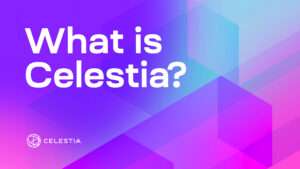Latest News
- Crypto Price Analysis 3-27: BITCOIN: BTC, ETHEREUM: ETH, SOLANA: SOL, CELESTIA: TIA, CARDANO: ADA, AAVE: AAVE, FILECOIN: FIL
- Celestia Under Pressure: Will Unlocks Catch Up On TIA Price?
- Crypto Price Analysis 3-24: BITCOIN: BTC, ETHEREUM: ETH, SOLANA: SOL, DOGECOIN: DOGE, CELESTIA: TIA, INJECTIVE: INJ, OPTIMISM: OP
- Top Crypto Picks of 2025: How Stellar, Celestia, BlockDAG, & Ripple Are Shaping the Future of Blockchain!
Celestia (TIA) presents a transformative approach to blockchain technology through its modular architecture, which aims to address the inherent limitations of traditional blockchains.
By separating key functions such as consensus and data availability, Celestia not only enhances scalability but also promotes the development of tailored solutions for various sectors.
However, as this innovative framework gains traction, it invites scrutiny regarding its practical applications and potential challenges.
Understanding how Celestia might redefine the blockchain landscape raises critical questions about its long-term implications and the evolving dynamics of decentralized networks.
Let’s dig into it.
Quick Overview
- Celestia utilizes a modular framework that separates consensus, data availability, and execution, enhancing scalability and performance.
- The unique data availability sampling technique reduces resource requirements for validators, fostering higher network participation.
- Its architecture supports the deployment of specialized rollups, enabling customized blockchain solutions across various sectors.
- Celestia promotes interoperability among diverse blockchain networks, facilitating seamless cross-chain transactions and collaborations.
- Potential challenges include scalability issues and regulatory compliance complexities due to diverse jurisdictional requirements.

Overview of Celestia
Celestia (TIA) emerges as a groundbreaking solution within the blockchain ecosystem, addressing key limitations of traditional architectures. Conventional blockchains often struggle with scalability and flexibility, as they attempt to combine consensus, data availability, and execution into a single layer. This monolithic approach can hinder performance and limit the ability to innovate.
Celestia introduces a modular framework that separates these functions, allowing developers to optimize each component independently. This innovative architecture enables the deployment of highly specialized blockchains that can cater to specific use cases.
By decoupling consensus and data availability from execution, Celestia allows for enhanced scalability, as multiple applications can operate concurrently without being bottlenecked by a singular chain’s limitations. Moreover, this design facilitates greater interoperability among diverse blockchain networks, promoting a more cohesive ecosystem.
In addition, Celestia’s unique data availability sampling mechanism guarantees that users can verify the availability of data without requiring access to the entire dataset. This greatly reduces resource requirements, making it accessible for a wider range of participants.
Key Features of Celestia
One of the standout attributes of Celestia is its modular architecture, which enables distinct layers for consensus, data availability, and execution. This separation not only enhances scalability but also improves the overall performance of decentralized applications.
By isolating these functions, developers can optimize each layer independently, allowing for tailored solutions that meet specific requirements.
Another significant feature is Celestia’s emphasis on data availability. Through its innovative approach, it guarantees that data is not only accessible but also verifiable, fostering trust among participants. This is particularly essential in decentralized systems, where data integrity is paramount.
Moreover, Celestia supports the deployment of sovereign rollups, enabling developers to create their own execution environments without being tethered to a monolithic blockchain. This flexibility encourages innovation, as developers can experiment with various models and protocols tailored to their unique needs.
Lastly, Celestia’s commitment to interoperability allows diverse blockchains to communicate seamlessly, paving the way for a more connected ecosystem.
Consensus and Data Availability
While many blockchain platforms struggle to balance consensus mechanisms with data availability, Celestia effectively addresses this challenge through its innovative modular approach. By decoupling consensus from execution and data availability, Celestia allows for increased scalability and flexibility in blockchain applications. This separation enables independent development of consensus protocols, which can be optimized for various use cases without being tied to a specific execution environment.
Celestia employs a unique data availability sampling technique, allowing nodes to verify the availability of data without needing to download the entire dataset. This considerably reduces the resource requirements for validators, facilitating broader participation in the network. As a result, Celestia enhances the overall robustness of the blockchain ecosystem, enabling efficient data propagation while ensuring that consensus can be achieved with minimal latency.
Additionally, the platform leverages cryptographic proofs to guarantee that data is retrievable and has not been tampered with, further securing the integrity of the information stored on the chain.
Comparison With Traditional Blockchains
Traditional blockchains typically integrate consensus, execution, and data availability into a single layer, which can lead to inefficiencies as network demand increases. This monolithic architecture can create bottlenecks, where each layer must scale simultaneously to accommodate higher transaction volumes. Consequently, as user activity surges, the entire network may experience slower transaction speeds and increased fees, limiting scalability.
In contrast, Celestia adopts a modular approach, separating these critical components into distinct layers. By decoupling consensus and data availability from execution, Celestia enables each layer to scale independently. This innovative structure allows for more efficient resource allocation and enhances overall throughput.
For instance, network participants can execute transactions off-chain while relying on Celestia’s robust consensus mechanism for data assurance. Furthermore, this separation allows developers to customize execution environments tailored to specific application requirements, fostering innovation without the constraints typically imposed by traditional blockchains.
Consequently, Celestia’s architecture not only addresses scalability challenges but also enhances flexibility, potentially paving the way for more diverse and sophisticated decentralized applications. Overall, the comparison highlights the advantages of modularity in improving both efficiency and adaptability in blockchain networks.

Use Cases and Applications
Celestia’s modular architecture opens up a wide array of use cases and applications, considerably expanding the possibilities for developers and enterprises alike. By decoupling consensus and data availability from execution, Celestia enables the creation of specialized rollups and blockchain solutions tailored to specific needs. This architecture is particularly beneficial for decentralized finance (DeFi) platforms, which demand high throughput and scalability without compromising security.
Furthermore, Celestia supports the deployment of custom blockchains for various industries, including supply chain management, healthcare, and identity verification. Enterprises can create permissioned networks that leverage Celestia’s robust data availability layer, ensuring that sensitive information remains secure while maintaining transparency.
Additionally, developers can experiment with innovative protocols and governance models, fostering a dynamic ecosystem for blockchain applications. The ability to seamlessly integrate multiple layer-2 solutions allows for enhanced interoperability, facilitating cross-chain transactions and reducing the friction commonly associated with traditional blockchain systems.
Benefits of Using Celestia
With its innovative modular design, Celestia offers numerous advantages that considerably enhance the blockchain development landscape. One of the most significant benefits is its scalability. By decoupling consensus and data availability from execution, Celestia allows developers to tailor their blockchain solutions to specific needs without the constraints of traditional monolithic architectures.
This modularity enables independent scaling, which can lead to increased throughput and reduced latency.
Additionally, Celestia enhances interoperability among blockchains. The platform’s architecture allows different chains to communicate and share data seamlessly, fostering an ecosystem where diverse applications can thrive.
This cross-chain capability is essential for fostering collaboration and innovation in the blockchain space.
Security is another compelling advantage. By utilizing a shared security model, Celestia reduces the risk of vulnerabilities that often plague isolated chains.
Developers can build on a robust foundation without needing to allocate significant resources to establish their own security protocols.
Potential Challenges and Limitations
While Celestia (TIA) presents innovative solutions, it also faces significant challenges that could impede its growth.
Scalability issues may arise as the network expands, potentially affecting performance and user experience.
Additionally, traversing regulatory compliance hurdles could complicate its adoption, impacting both developers and end-users in various jurisdictions.
Scalability Issues
Addressing scalability issues presents a significant challenge for Celestia (TIA) as it seeks to optimize its modular blockchain architecture. Celestia aims to decouple consensus and data availability, allowing for increased flexibility and specialization. However, this innovative approach introduces complexities in scaling the network effectively.
One major concern is the potential bottleneck in data availability. As the network grows, ensuring that all nodes can efficiently access and verify data becomes more challenging. This issue is exacerbated by the need for nodes to maintain a high level of performance while processing an increasing volume of transactions.
Additionally, while modular architectures theoretically allow for more scalable solutions, they also require robust interoperability between layers. As different modules must communicate seamlessly, any latency or inefficiency can hinder overall performance.
Furthermore, the reliance on a limited number of validators for consensus can create centralization risks, which may undermine the very scalability Celestia aims to achieve. Balancing decentralization with the need for speed and efficiency is a critical concern.
Regulatory Compliance Hurdles
Steering regulatory compliance presents a formidable challenge for Celestia (TIA) as it operates within a rapidly evolving legal landscape. The intersection of innovative blockchain technology with existing regulatory frameworks necessitates a careful and strategic approach.
As Celestia seeks to gain traction in the decentralized ecosystem, it must navigate several potential hurdles that could impede its progress.
Key regulatory compliance challenges include:
- Diverse Jurisdictional Regulations: Different countries have varying laws concerning blockchain and cryptocurrency, complicating compliance efforts.
- Data Privacy and Security: Adhering to regulations such as GDPR requires robust data management practices, which can be resource-intensive.
- Anti-Money Laundering (AML) Compliance: Implementing effective AML measures is vital to avoid legal repercussions and maintain user trust.
- Intellectual Property Issues: Protecting proprietary technology while respecting existing patents poses significant legal challenges.
These hurdles necessitate ongoing dialogue with regulators and a proactive compliance strategy.
Failure to effectively address these issues could stymie Celestia’s growth and undermine its competitive position in the market.
Addressing these regulatory compliance hurdles is essential for the long-term success of Celestia in the blockchain ecosystem.

Future Outlook for Celestia
As Celestia continues to carve out its niche in the blockchain ecosystem, the future outlook for the platform appears promising, driven by its innovative approach to scalability and modularity.
By decoupling consensus and data availability from execution, Celestia allows developers to create customized blockchain solutions without the constraints of traditional architectures. This flexibility is likely to attract a diverse range of projects, particularly those focused on decentralized applications (dApps) and Layer 2 solutions.
Moreover, the increasing demand for scalable blockchain solutions positions Celestia favorably in a competitive landscape. As more enterprises and developers seek to integrate blockchain technology, Celestia’s unique architecture may serve as a catalyst for broader adoption.
The platform’s commitment to interoperability will also play an essential role, enabling seamless communication between various blockchain networks.
Investments in research and development could further enhance Celestia’s capabilities, reinforcing its market position. However, challenges such as regulatory compliance and network security will need continuous attention.
Frequently Asked Questions
What Is the Origin of Celestia’s Development Team?
The development team behind Celestia originated from a collective of blockchain researchers and engineers, focusing on scalability and modular architecture. Their expertise in distributed systems and consensus mechanisms has greatly influenced the project’s innovative design and objectives.
How Does Celestia Handle Security Concerns?
Celestia addresses security concerns through a multi-layered approach encompassing cryptographic protocols, decentralized consensus mechanisms, and continuous auditing processes. This strategy enhances resilience against attacks while ensuring data integrity and user privacy within its ecosystem.
What Programming Languages Are Supported by Celestia?
Celestia supports various programming languages, including Rust and Go, facilitating ease of development and integration. This versatility allows developers to leverage their existing skills while building decentralized applications and services within its modular architecture.
Can I Stake TIA Tokens?
Yes, you can stake TIA tokens to participate in the network’s consensus mechanism. Staking typically involves locking tokens for a period, allowing holders to earn rewards while contributing to network security and functionality.
How Can I Participate in the Celestia Community?
To participate in the Celestia community, engage through official communication channels such as forums and social media platforms, contribute to discussions, attend community events, and collaborate on projects that align with the network’s development goals.
Wrapping Up
Celestia represents a significant advancement in blockchain technology through its modular architecture, effectively addressing scalability and performance limitations inherent in traditional blockchains.
By decoupling consensus, data availability, and execution, Celestia enables the creation of specialized blockchains for diverse applications.
Although challenges remain, including potential security concerns and resource dependencies, the innovative design fosters enhanced interoperability and trust.
The future outlook for Celestia appears promising, positioning it as a pivotal player in the evolving blockchain landscape.

